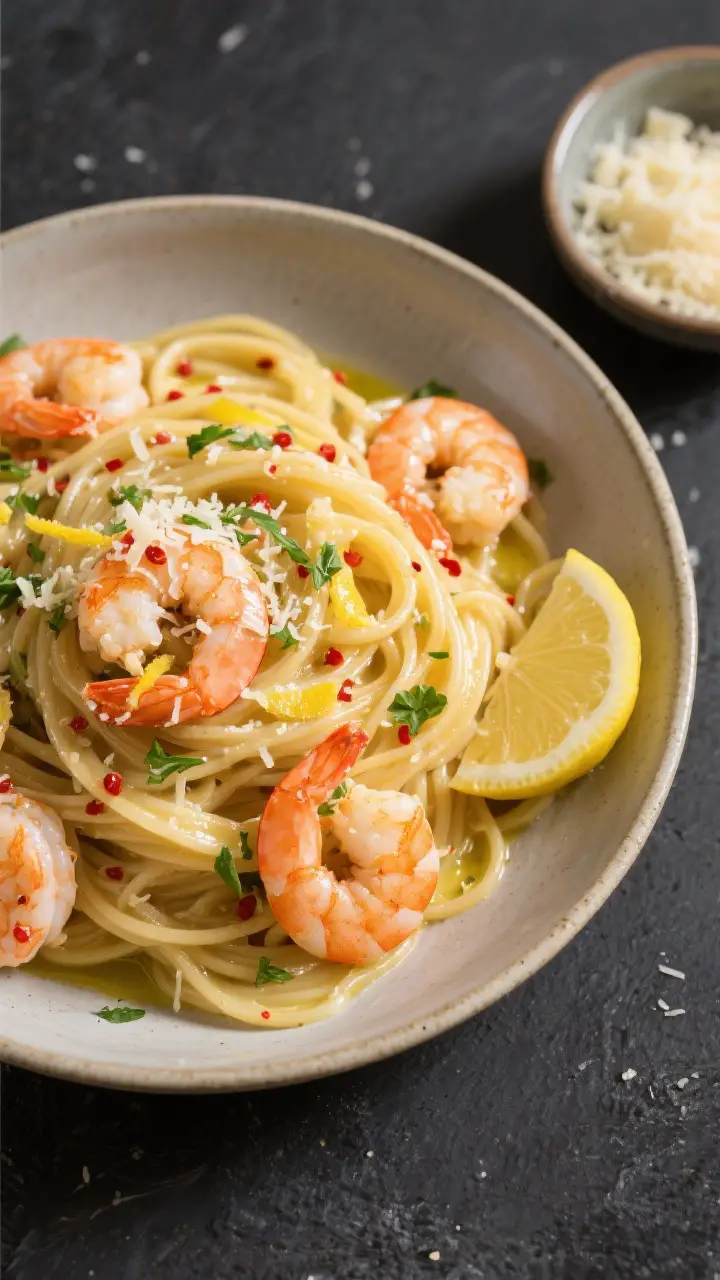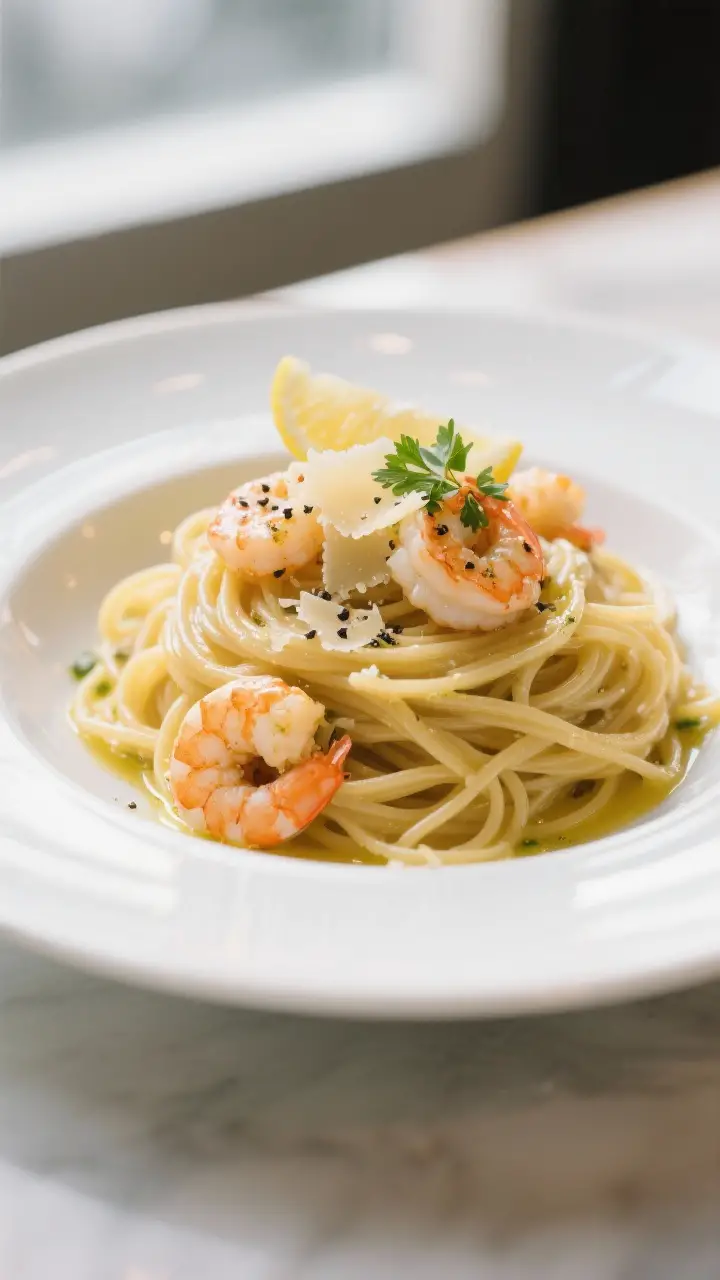Shrimp, butter, garlic, and pasta—sometimes the simplest combinations make the most satisfying meals. This Garlic Butter Shrimp Linguine brings restaurant-level flavor to your kitchen with very little effort. The sauce is silky, bright with lemon, and boosted by a touch of white wine and chili flakes.
It’s the kind of dish you can pull together on a busy weeknight but still proudly serve to guests. Expect tender shrimp, glossy linguine, and a buttery garlic aroma that fills the room.
What Makes This Special

This recipe is all about balance. The butter and garlic give rich depth, while lemon juice and white wine keep things light and lively.
A quick toss with al dente linguine helps the sauce cling to every strand, and a sprinkle of parsley adds a fresh finish. It’s fast—on the table in under 30 minutes—and uses pantry-friendly ingredients you may already have. Plus, it scales easily for date night or a family dinner.
Shopping List
- Linguine: 12 ounces
- Shrimp: 1 pound large shrimp, peeled and deveined (tails on or off)
- Unsalted butter: 5 tablespoons
- Olive oil: 1 tablespoon
- Garlic: 5–6 cloves, finely minced
- Crushed red pepper flakes: 1/2 teaspoon (adjust to taste)
- Dry white wine: 1/3 cup (or chicken broth)
- Lemon: Zest of 1 lemon and 2 tablespoons lemon juice
- Fresh parsley: 1/4 cup chopped
- Parmesan cheese: Freshly grated, about 1/3 cup, plus more for serving
- Salt and black pepper: To taste
- Pasta cooking water: Reserve 1/2–3/4 cup
Instructions

- Boil the pasta: Bring a large pot of salted water to a rolling boil.
Cook linguine until just shy of al dente according to package directions. Reserve 1/2–3/4 cup of the starchy pasta water, then drain.
- Prep the shrimp: Pat shrimp dry with paper towels. Season with a pinch of salt and pepper.
Dry shrimp sear better and stay juicy.
- Sear the shrimp: Heat 1 tablespoon olive oil and 1 tablespoon butter in a large skillet over medium-high heat. Add shrimp in a single layer. Cook 1–2 minutes per side until pink and opaque.
Transfer to a plate. Do not overcook.
- Build the sauce base: Reduce heat to medium. Add 3 tablespoons butter to the skillet.
Stir in the minced garlic and red pepper flakes. Cook 30–60 seconds, stirring, until fragrant but not browned.
- Deglaze with wine: Pour in the white wine and scrape up any browned bits. Simmer 1–2 minutes to let the alcohol cook off and the liquid reduce slightly.
If not using wine, use chicken broth.
- Add lemon and seasoning: Stir in lemon zest and lemon juice. Taste and season with salt and pepper. The sauce should taste bold and bright at this stage.
- Toss the pasta: Add the drained linguine to the skillet.
Pour in 1/4–1/2 cup reserved pasta water and toss vigorously to emulsify the butter and liquid into a glossy sauce that coats the noodles.
- Finish with shrimp and cheese: Return shrimp to the pan along with chopped parsley and the Parmesan. Toss until everything is hot and well-coated. If the pasta looks dry, add a splash more pasta water.
If it’s too loose, let it cook 30 seconds longer.
- Serve: Taste and adjust seasoning with more lemon, salt, or pepper. Serve immediately with extra Parmesan, a drizzle of olive oil, and a pinch of chili flakes if you like heat.
Storage Instructions
Garlic Butter Shrimp Linguine is best enjoyed fresh. If you have leftovers, cool and store them in an airtight container in the fridge for up to 2 days.
Reheat gently in a skillet over low heat with a splash of water or broth to loosen the sauce. Avoid the microwave if possible—shrimp can toughen quickly. Do not freeze; the texture of the shrimp and sauce won’t hold up well.

Health Benefits
- Lean protein: Shrimp is high in protein and low in fat, which helps keep you satisfied without weighing you down.
- Nutrient-rich: Shrimp provides selenium, vitamin B12, iodine, and omega-3 fatty acids that support metabolism and heart health.
- Portion-friendly carbs: Linguine offers energy, and pairing it with protein and healthy fats can help with balanced blood sugar.
- Garlic and herbs: Garlic may support cardiovascular health, while parsley adds antioxidants and a dose of vitamin K.
- Customizable fat content: You control butter and cheese amounts.
For a lighter dish, reduce butter by 1 tablespoon and increase lemon and parsley.
Common Mistakes to Avoid
- Overcooking shrimp: Shrimp cook fast. Pull them off the heat as soon as they turn pink and opaque to keep them tender.
- Skipping pasta water: The starchy water emulsifies the sauce, helping it cling to the linguine. Don’t forget to reserve it.
- Burning the garlic: Garlic turns bitter if browned.
Lower the heat and cook it just until fragrant.
- Not seasoning enough: Salt your pasta water generously and taste the sauce as you go. Lemon and salt should be balanced.
- Adding cheese too early: Parmesan can clump if added before the sauce is emulsified. Toss with pasta first, then add cheese at the end.
Recipe Variations
- Garlic butter scampi style: Add an extra tablespoon of butter and a splash more wine.
Finish with more parsley and lemon for a classic scampi vibe.
- Veggie boost: Sauté cherry tomatoes, asparagus tips, or baby spinach before adding the wine. They add color and freshness.
- Creamy twist: Stir in 1/4 cup heavy cream after the wine reduces for a richer, silkier sauce.
- Whole wheat or gluten-free: Swap in whole wheat linguine or your favorite gluten-free pasta. Adjust cooking times accordingly.
- Herb upgrade: Add fresh basil, chives, or a touch of tarragon for a more aromatic finish.
- Extra heat: Use Calabrian chili paste instead of flakes for a deeper, fruity spice.
- No alcohol: Use chicken or vegetable broth with a splash of apple cider vinegar for brightness.
FAQ
Can I use frozen shrimp?
Yes.
Thaw them overnight in the fridge or quickly under cold running water, then pat dry thoroughly. Wet shrimp won’t sear well and may turn rubbery.
What kind of shrimp works best?
Large or extra-large shrimp (16/20 or 21/25 count) work best for texture and quick cooking. Smaller shrimp can overcook more easily.
Do I have to use white wine?
No.
Broth works fine. If you want that slight tang, add a small splash of lemon juice or cider vinegar to mimic the acidity of wine.
How can I make it dairy-free?
Use dairy-free butter and skip the Parmesan, or replace it with a sprinkle of toasted breadcrumbs and nutritional yeast for savory notes.
How do I keep the sauce from breaking?
Emulsify with pasta water and toss over medium heat. Add cheese off the heat or at low heat.
Avoid boiling the sauce after adding butter and cheese.
Can I use another pasta shape?
Yes. Spaghetti, fettuccine, or even short shapes like penne work. Long noodles hold the silky sauce best, but use what you have.
What if my shrimp taste bland?
Season the shrimp before searing, and season the sauce at multiple stages.
A final squeeze of lemon and a pinch of salt right before serving wakes everything up.
Final Thoughts
Garlic Butter Shrimp Linguine is the kind of pasta that feels special without asking much of you. With a few smart steps—searing the shrimp quickly, using pasta water, and balancing butter with lemon—you get a glossy, flavorful bowl in minutes. Keep this recipe in your weeknight rotation, and don’t be afraid to tweak it with veggies, herbs, or a creamier finish.
Simple, fresh, and reliably delicious—just the way pasta should be.
Printable Recipe Card
Want just the essential recipe details without scrolling through the article? Get our printable recipe card with just the ingredients and instructions.

